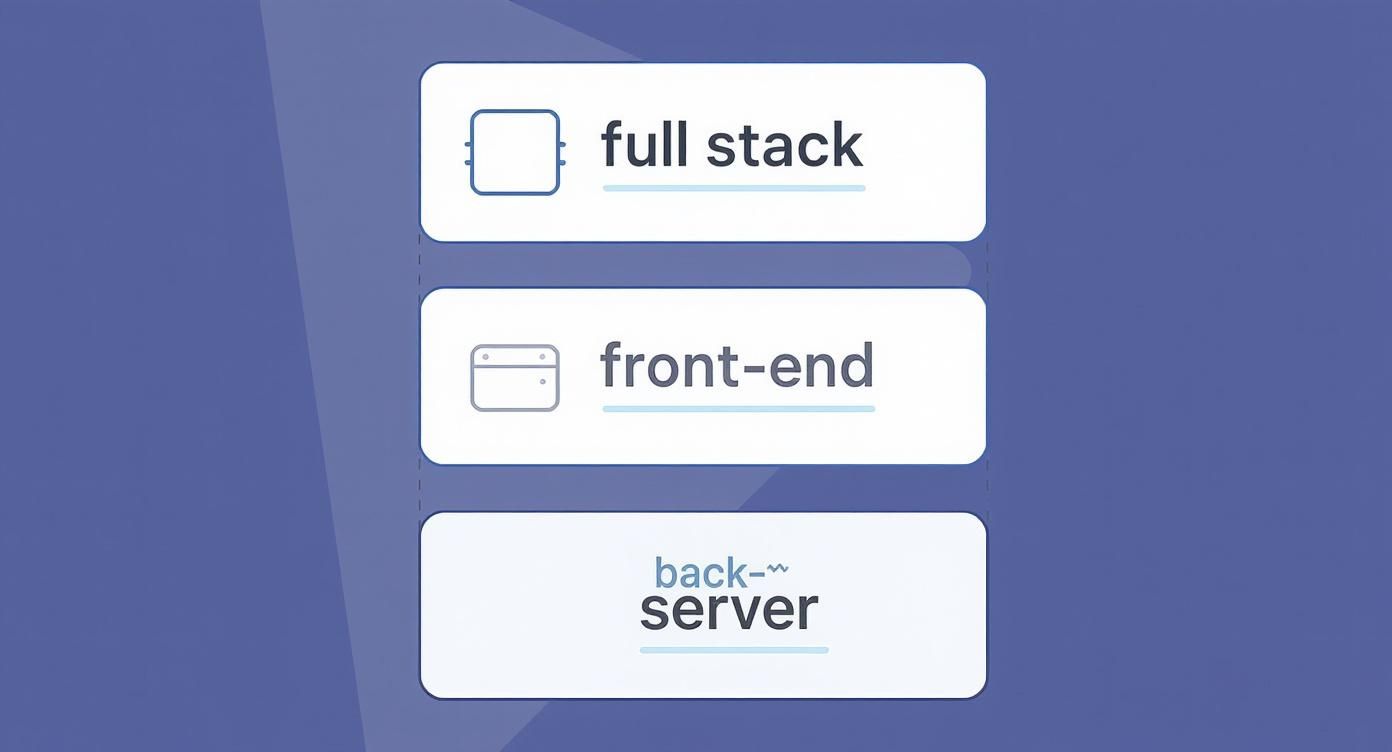Full stack web development is all about building a complete web application, end-to-end. It means handling everything the user sees and interacts with (the front-end) and everything that happens behind the scenes on the server, in the database, and with the application's logic (the back-end). It’s a role that merges multiple skill sets, letting one developer take a project all the way from an idea to a fully functioning product.
Understanding the Full Stack Philosophy
Let's use an analogy. Think of any website or app as a restaurant.
When you walk in as a customer, everything you see—the dining room, the menus, the decor, the server who takes your order—is the front-end. It's the part you directly experience.
The kitchen, though, is the back-end. It’s where your order gets processed, the food is cooked, ingredients are managed, and all the magic happens to deliver your meal. You don't see it, but without it, the restaurant couldn't function.
A full stack developer is both the head chef and the dining room manager. They understand how the front-of-house and back-of-house need to work together perfectly to create a great experience for the customer. This big-picture view lets them build and manage the entire application from start to finish.
The "stack" itself is just the collection of technologies used to make it all happen. This typically includes:
- Front-End Technologies: The languages and frameworks that run in your browser, like HTML, CSS, JavaScript, and popular frameworks like React.
- Back-End Technologies: The server-side languages, databases, and servers that do the heavy lifting, such as Node.js, Python, and SQL.
- Supporting Tools: Essential software that supports the development process, like version control with Git or cloud platforms like AWS.
This diagram breaks down how the two sides connect to form the complete stack.

As you can see, a full stack developer is someone who is comfortable working across both of these layers.
The Three Layers of a Web Application
To quickly summarize these core components, this table breaks down the essential layers a full stack developer manages, continuing our restaurant analogy.
| Layer | Analogy (Restaurant) | Core Function |
|---|---|---|
| Front-End (Presentation Layer) | The Dining Room & Menu | Everything the user sees and interacts with directly. |
| Back-End (Logic Layer) | The Kitchen & Staff | Processes requests, runs application logic, and handles data. |
| Database (Data Layer) | The Pantry & Walk-In Fridge | Stores, retrieves, and organizes all the application's data. |
Understanding how these three layers communicate is the essence of full stack development.
The Value of a Unified Perspective
When a developer understands the whole system, they can solve problems much more efficiently. If a button isn't working, they can quickly figure out if it's a visual bug on the front-end or an error in how the server is processing data on the back-end.
This versatility makes them incredibly valuable, especially in smaller teams or startups where everyone needs to wear multiple hats.
A full stack developer isn't necessarily an expert in everything. They are a versatile problem-solver with a broad understanding of the entire system, capable of building functional applications independently and communicating effectively across technical disciplines.
So, what is full stack web development at its core? It's about bridging the gap between what the user sees and all the complex machinery that makes it work seamlessly.
Building The User Experience With Front-End Technology

The front-end is everything a user sees and touches in a web application. Think of it as the storefront, the interior design, and all the interactive displays in a physical shop. A full stack developer has to master this client-side world to build experiences that are not just functional but genuinely engaging and easy to use.
At the heart of every website or web app, you'll find three core technologies working together. Each one has a specific, vital job in bringing a web page to life, and a full stack developer needs to know exactly how they fit together.
The Foundational Trio Of The Web
If you were building a house, you'd need a solid frame, a visually appealing design, and functional utilities like electricity and plumbing. The front-end trio works the same way:
- HTML (HyperText Markup Language): This is the skeleton of your website. It provides the basic structure, defining all the essential pieces like headings, paragraphs, images, and buttons.
- CSS (Cascading Style Sheets): This is your interior designer. CSS is all about the visual presentation—it controls the colors, fonts, layouts, and spacing that make a website look polished and professional.
- JavaScript (JS): This is the electrician and plumber. JavaScript adds all the interactivity and dynamic behavior that makes the site do things, handling everything from form submissions and animations to complex user interactions.
When these three work in harmony, they turn a static document into a rich, interactive experience. Getting this right is critical. Studies show that a staggering 88% of online consumers are less likely to return to a website after a bad user experience. To dig deeper, check out these user experience design best practices that can make a huge difference.
Modern Frameworks That Speed Up Development
Trying to build a complex, modern website using only raw HTML, CSS, and JavaScript would be like building that house from scratch by cutting down your own trees. It's possible, but incredibly time-consuming. This is where front-end frameworks and libraries come in. These tools provide pre-written, reusable code that helps developers build sophisticated applications much, much faster.
A front-end framework is like a set of high-quality, prefabricated building materials. Instead of cutting every piece of lumber by hand, you get pre-built wall sections and window frames, letting you construct a better house in less time.
Some of the most popular tools in a full stack developer's kit include:
- React: A JavaScript library from Facebook for building dynamic user interfaces with a component-based structure. It's incredibly popular for single-page applications.
- Vue.js: A progressive framework known for its simplicity and gentle learning curve, which makes it easy to adopt for projects of any size.
- Angular: A comprehensive platform from Google, often used for building large-scale, enterprise-level applications that demand a structured approach.
When it comes to choosing technologies for building apps that work across different platforms, a detailed Flutter vs. React Native comparison can be a huge help. By using these powerful tools, a full stack developer can efficiently create the seamless, responsive, and engaging digital storefronts that modern businesses need to thrive.
Powering Applications with Back-End Technology
 If the front-end is the dining room of our restaurant, the back-end is the bustling kitchen, the stockroom, and all the unseen operations that actually get the meal on your plate. This is the server-side world where the application's core logic lives. It’s responsible for processing data, managing user accounts, and doing all the heavy lifting behind the scenes.
If the front-end is the dining room of our restaurant, the back-end is the bustling kitchen, the stockroom, and all the unseen operations that actually get the meal on your plate. This is the server-side world where the application's core logic lives. It’s responsible for processing data, managing user accounts, and doing all the heavy lifting behind the scenes.
A full stack developer has to be fluent in this domain, knowing how to build the robust engine that powers the entire user-facing experience. The back-end really boils down to three main components that have to work together perfectly.
The Core Components of the Back-End
Every powerful application relies on a well-structured server-side architecture. This includes the server itself, the application logic running on it, and the database where all the information is stored.
- Server: This is the computer, often somewhere in the cloud, that receives requests from a user's browser. Its whole job is to listen for these requests and send back the right data or web page.
- Application Logic: This is the "brain" of the operation. It's code written in languages like Node.js (which uses JavaScript), Python, or Ruby that defines how the application behaves. It handles tasks like authenticating users, processing payments, and enforcing business rules.
- Database: Think of this as the application’s long-term memory. It’s where all the crucial data—user profiles, product inventory, blog posts—is stored, organized, and retrieved when needed.
Together, these three elements form a powerful trio that executes commands, manages data, and ensures the whole system runs smoothly. A solid back-end architecture is also your first line of defense; you can dig deeper into these web application security best practices.
How Databases Organize Information
Databases aren't one-size-fits-all. A full stack developer chooses the right type based on what the application needs, and they generally fall into two main categories.
SQL databases are like a perfectly organized library. Every book (data) has a specific place on a shelf (table) according to a strict cataloging system (schema). This structure makes it incredibly reliable for finding related information.
NoSQL databases are like a flexible filing cabinet. You can toss in documents of all shapes and sizes without a rigid structure. This is fantastic for handling huge amounts of unstructured data very quickly.
APIs: The Crucial Messengers
So, how does the front-end (dining room) actually talk to the back-end (kitchen)? They communicate through an Application Programming Interface (API).
Think of an API as the waiter who takes your order from the table to the kitchen and brings the finished meal back out to you. It's the essential go-between.
When you click "buy now" on an e-commerce site, the front-end sends a request through an API to the back-end. The back-end processes the order, updates the database, and sends a confirmation back to the front-end via that same API. This constant back-and-forth communication is what creates a seamless user experience.
The technologies used here are always evolving. For instance, Node.js is used by a whopping 41% of developers, making it a major player in back-end development. You can find more stats about how new trends are shaping software development.
The Essential Toolkit That Ties It All Together
A truly great developer knows that writing clean front-end and back-end code is only half the battle. To really understand full stack development, you have to master the tools that hold the entire process together—from the first line of code to getting your application into the hands of users.
Think of these technologies as the connective tissue for any modern software project. They’re what make it possible to build things efficiently, work with a team, and keep everything from falling apart.
One of the most fundamental tools in this kit is version control, and Git is the undisputed king. Imagine Git as a sophisticated time machine for your code. It takes snapshots of your project every time you make a change, letting you rewind to an earlier version if something goes wrong.
Even better, it lets you see exactly who changed what and when. For teams, this isn't just nice to have; it's non-negotiable. It’s how multiple developers can work on the same project without stepping on each other's toes.

Automating the Path to Production
Once your code is written and tracked in Git, you need a reliable way to get it to your users. This is where the principles of DevOps come in. DevOps isn't just a tool; it's a culture that brings software development (Dev) and IT operations (Ops) together to ship high-quality software faster.
A core part of DevOps is the CI/CD pipeline, which stands for Continuous Integration/Continuous Deployment. It's like an automated assembly line for your code.
- Continuous Integration (CI): This is where code changes from everyone on the team are automatically merged into a central hub. Every time new code is added, an automated build and test sequence kicks off to catch bugs before they cause real problems.
- Continuous Deployment (CD): Once the CI stage passes its tests, this practice automatically pushes the code out to the production environment. New features get to users quickly and reliably, without a human needing to flip a switch.
These pipelines are game-changers. They cut down on manual errors and seriously speed up how quickly you can deliver value. You can dig deeper into some of the best practices for web development that top-tier teams rely on.
The Infrastructure Powering Modern Apps
Finally, every application needs a place to live. That's where cloud platforms like Amazon Web Services (AWS), Google Cloud, and Microsoft Azure come in. They provide all the computing power you need to run your application without ever having to touch a physical server.
Containerization tools take this a step further, and the most popular one by far is Docker. Docker bundles up an application and all its dependencies into a neat little package called a container. This ensures your app runs exactly the same way everywhere—from your laptop to a massive server in the cloud.
The whole ecosystem is massive, and it's where the industry is heading. In fact, enterprise spending on software is expected to hit a staggering $1.25 trillion in 2025, with cloud and DevOps being huge drivers of that growth. This proves that being a full stack expert is about much more than just writing code; it’s about understanding the entire ecosystem that brings an application to life.
Essential Full Stack Developer Toolkit
Beyond just coding languages, a full stack developer's toolkit is filled with technologies that manage the entire software lifecycle. Here's a quick look at the key categories and why they matter.
| Category | Example Technologies | Primary Purpose |
|---|---|---|
| Version Control | Git, GitHub, GitLab | Tracking code changes and enabling team collaboration. |
| Cloud Platforms | AWS, Google Cloud, Microsoft Azure | Providing scalable infrastructure for hosting applications. |
| Containerization | Docker, Kubernetes | Packaging applications and their dependencies to run consistently anywhere. |
| CI/CD Tools | Jenkins, CircleCI, GitHub Actions | Automating the build, test, and deployment of software. |
These tools aren't just add-ons; they are central to modern development. Mastering them is what separates a good coder from a truly effective full stack developer who can deliver reliable, scalable applications from start to finish.
Why Modern Businesses Value Full Stack Developers
It’s one thing to understand what a full stack developer does, but it’s another to grasp why they’ve become such a critical asset for modern businesses. Their value goes way beyond just writing code—it hits the company's efficiency, speed to market, and bottom line directly.
Think of a traditional dev team like a crew building a house. You have a plumber, an electrician, and a carpenter. If a problem crops up that involves both wiring and pipes, they have to coordinate. That means meetings, potential miscommunications, and delays. A full stack developer is more like a master builder who understands all of those systems. They can spot a complex issue and fix it themselves, often in a fraction of the time.
That unified perspective is a massive advantage.
Driving Speed and Innovation
In any market that moves fast, speed is everything. Full stack developers are in a unique position to slash project timelines simply by cutting down the friction between front-end and back-end teams.
Because they get the whole picture—from the user interface all the way down to the database—they can make decisions and push changes without waiting for another team’s approval. This kind of autonomy is a game-changer for startups that need to get a Minimum Viable Product (MVP) out the door fast to see if an idea has legs. They can build, test, and pivot way faster than teams stuck in specialized silos.
A single developer who sees the whole picture can often solve problems in hours that might take days of meetings and handoffs between separate front-end and back-end teams. This agility translates directly into a competitive edge.
This demand is making waves in the market. The web development services market is projected to jump from $74.69 billion in 2025 to $104.31 billion by 2030. A lot of that growth is being driven by professionals who can bridge both sides of an application. It's a competitive space, too; with 59% of website development being outsourced, developers who can manage the entire stack are the ones who stay indispensable. You can dig into more stats about the growing web development market on blacksmith.agency.
Creating More Cohesive Products
Beyond just moving faster, a full stack developer’s wide-ranging knowledge leads to better, more thoughtfully built products. When one person understands how a click on the front-end will ripple through to the back-end database, they can design features that aren't just functional but are also efficient and scalable from day one.
This holistic view gets rid of the all-too-common "that's not my department" headache. Instead of building features in isolated chunks that get stitched together later, a full stack developer architects them as a single, unified system. The result is a more robust application that delivers a smoother user experience and is far easier to maintain down the road, saving the business a ton of time and money in the long run.
Your Roadmap to Becoming a Full Stack Developer
Jumping into full stack development isn't just about learning a bunch of technologies; it's a commitment to constant learning. You're signing up to be a versatile builder, the kind of person who can confidently navigate any part of an application. The real goal isn't to know everything—that’s impossible—but to develop a problem-solver's mindset.
Think of it this way: your first job is to build a solid foundation of essential hard skills. This is your technical toolkit, the backbone of everything you'll create.
Building Your Technical Foundation
A master craftsperson wouldn't try to build a house with just a hammer, and you can't build a modern web application with just one programming language. You need a full toolkit, and that means getting comfortable across the entire stack.
The best way to do this is to start with the basics and add more advanced tools as you go:
- Front-End Essentials: Get your hands dirty with HTML, CSS, and JavaScript. Once you have those down, pick up a modern framework like React or Vue.js.
- Back-End Programming: You'll need to master a server-side language. Node.js is a fantastic choice since it uses JavaScript, but Python is also incredibly popular and versatile.
- Database Management: Don't just learn one type. Get familiar with both SQL (like PostgreSQL) and NoSQL (like MongoDB) to understand different ways to store and retrieve data.
- Version Control: Knowing how to use Git is completely non-negotiable. It's the universal language for collaboration in software development.
But it's not just about the code. You also need to understand the ecosystem that keeps modern applications running. That means getting familiar with cloud platforms like AWS and containerization tools like Docker. Once you start building up these skills, figuring out how to craft a perfect software engineer resume is the crucial next step to show off what you can do.
Mastering Essential Soft Skills
Pure technical skill will only get you so far. The developers who really stand out are the ones who pair their coding chops with strong soft skills. It’s what allows them to work well with others and tackle really complex challenges.
Problem-solving is the true core of development. The code is just the medium. Great developers are defined by their ability to break down complex problems into manageable steps and find elegant, efficient solutions.
Of course, your career path will also be shaped by what's happening in the market. In major tech hubs, for example, full stack developers can earn 20% more than their peers in other regions. It's also worth noting that web application developers often earn 13.5% less than mobile app developers. Ultimately, though, a relentless curiosity and a genuine passion for learning will be your most valuable assets on this journey.
Frequently Asked Questions About Full Stack Development
Even after covering the basics, a few specific questions always pop up when people start digging into full stack development. Let's tackle some of the most common ones we hear from aspiring developers and business owners.
Do I Need to Be an Expert in Every Single Technology?
Absolutely not. Trying to master every tool out there is a recipe for burnout, and frankly, it's impossible. Instead, good full stack developers are often described as “T-shaped.”
What does that mean? They have a broad, general understanding of many technologies across the front-end and back-end—that’s the horizontal bar of the 'T'. But they also dig deep and build specialized expertise in one or two key areas they really click with. That's the vertical stem of the 'T'. The most valuable skill isn't knowing everything, but being versatile enough to learn and adapt as a project demands.
Which Programming Language Should I Learn First?
If you're just starting out, JavaScript is a fantastic first choice. It’s in a unique spot because it's the only language that runs natively on both the front-end (in every modern browser) and the back-end (thanks to Node.js).
This lets you build a complete, working application using just one language, which makes the initial learning curve a lot less steep. Once you're comfortable with JavaScript, picking up another powerful back-end language like Python or Ruby feels like a much more manageable next step.
The most valuable skill for a full stack developer is not knowing everything, but knowing how everything fits together. It's about seeing the complete system and understanding how to connect the dots between the user interface and the server logic.
Is Full Stack Development Still Relevant With the Rise of AI?
Yes, and it’s arguably more relevant than ever. AI tools are becoming incredible assistants that can automate coding tasks and speed up the development process, but they don't replace the strategic and architectural mind of a developer.
A full stack developer’s ability to see the big picture is crucial for designing efficient systems and figuring out the best way to plug in AI tools. They are perfectly positioned to integrate specialized AI components, troubleshoot weird issues that cross the entire stack, and make sure the whole system plays nicely together.
Ready to build a web application that drives real results? At Up North Media, we specialize in creating custom web solutions that boost revenue and accelerate growth. Contact us today for a free consultation.
